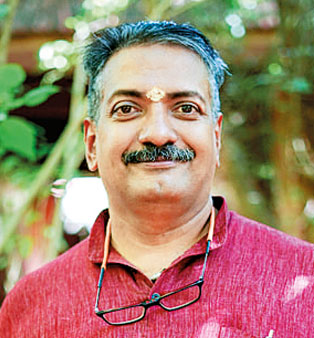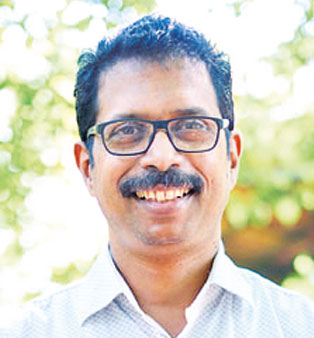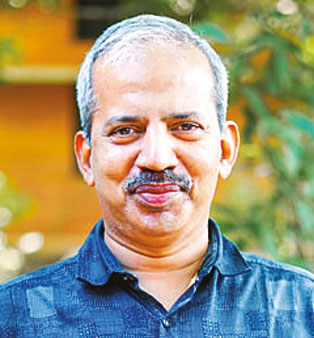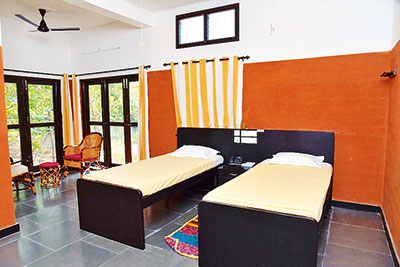
A question and answer session with patients
Healing at Vaidyagrama
Jyoti Pande Lavakare
GENTLE, smiling therapists help me off the hard and slippery wooden table, bathing me like a baby, with lukewarm water and powdered green gram, wiping me down with a rough, thin cotton towel.
Then, they apply rasnadichoornam on the crown of my head and wave it under my nose, to prevent me catching cold, also smearing chandan and kumkum on my forehead and throat.
After measuring my blood pressure, they send me back to my room, where a tiny, double-bottomed steel cup of warm green gram soup awaits me.
I am at Vaidyagrama, a healing village 40 km from Coimbatore in a dusty and remote corner of the foothills of the Nilgiris. It is a centre for traditional Ayurvedic therapies.
My journey here is more than just the flight and car rides from my comfortable home in south Delhi. It is really a leap of faith.
In my desperate search for healing and a reset through traditional medicine, I had surveyed and checked out many facilities. None seemed to be what I was looking for. They were either too slick or too dour. A retreat near Palakkad in 2011 had been good and yet not the real thing.
But after I found Vaidyagrama, I went rapidly, as though preordained, from Vaidyagrama’s homepage on the internet to turning up there to lay claim to the sparse room and frugal meals that awaited me.
Vaidyagrama was what I had been looking for. Instantly, there was a sense of belonging. Its remoteness enveloped me. An easy flow and uncontrived simplicity embraced me and I merged with it easily.
As part of the initiation for patients, one of the vaidyas, or traditional Ayurvedic physicians, spoke of the importance of surrendering to the Ayurvedic treatment that was to follow, of going along with the Universe.
To allow another grown human being to bathe you, as I have just described, is to truly hand yourself over. It is the kind of surrender from which inner beginnings are made.
My quest for such a place began with the personal turmoil that followed my mother’s passing from lung cancer which could be traced to air pollution and long years in Delhi. The loss of a parent brings unanticipated grief. Additionally, it made me angry that she had died from a disease merely because she breathed. It was hers and everyone’s right to breathe safely.
After her passing, I wrote a grief memoir referencing air pollution to put the issues surrounding it more firmly in the public domain. Prolonged sitting to get the book out quickly had resulted in tailbone pain. And then I got infected with the Delta variant of COVID-19 which left my body wracked.
The 17 days I spent at Vaidyagrama didn’t result in a miraculous cure. But they introduced me to Ayurveda in ways more wondrous than I could have thought possible.
I am city-bred and long accustomed to the hurly-burly of urbanized living. As I entered my small room in Vaidyagrama, with its limited furniture, no television and weak telecom signals, I confess I wondered how the days would pass.
Time did hang heavy to begin with, but as the daily rhythm took me along, I realized that the slowness of everything was therapeutic. It was at the heart of the treatment I had sought out, together, of course, with a lot more like the changes in diet, ingesting of ghee, oil massages and use of herbs.
At Vaidyagrama, patients are gently discouraged from doing anything vigorously — walking and yoga included. The treatment lies in finding inner balance and discovering the boundaries of your being. Silence and slowness are needed for this. It is an internal process.
FOUR FRIENDS AND A DREAM
The more I learnt about Ayurveda, the more I found I learnt about Vaidyagrama, so intricately were the two linked.
Vaidyagrama was created in 2008 by four third-generation vaidyas who had studied around the same time at the Coimbatore Ayurvedic College in the foothills of the Nilgiri mountains.
Although they didn’t know it then, their experience of learning the science of Ayurveda in the lap of nature in the gurukul-like environment of their college in the late 1980s was going to lead to the creation of Vaidyagrama 20 years later.
 |
| Dr Ramkumar |
“We used to have elephants walking up to our windows. Often, we bathed under clear, cold waterfalls — something we didn’t much like back then. But college, being so close to nature, left a deep impact on us. We also found our life there prepared us well in body and mind. It made us as strong as steel. It reinforced in us how Ayurveda should work for people,” says Dr Ramkumar Kutty, one of the founders.
But over the years, Ayurveda hospitals were becoming fancier in order to match conventional hospitals and raise the comfort levels of patients. They were providing air conditioning, television and internet connections in rooms.
“This was not how it was meant to be,” says Dr Ramkumar, recalling the growing dismay among Ayurvedic physicians who had begun to feel that the drift in values would undermine the nuanced scientific foundations of the system they had been trained in.
 |
| Dr Ramadas |
It was around then Dr A.R. Ramadas, Dr E.K. Ramanandan and Dr K.K. Harikrishnan, his college mates from the late 1980s who were all working in their traditional family practices at that time, came together with him to create Vaidyagrama.
“The land here was barren. There was hardly any water, so farmers were happy to sell to us. The first thing we did was to set up six wells to recharge the groundwater,” recalls Dr Ramadas.
Thanks to that water harvesting, today, almost 14 years later, despite the growing community, Vaidyagrama is water self-sufficient with five borewells and no piped municipal water.
At first, the four vaidyas and their supporters had no resources — just their ideas and their idealism — but they pushed ahead, designing their community as a natural healing environment.
 |
| Dr E.K.Ramanandan |
They minimized the use of chemicals, chose natural materials for construction and adopted renewable approaches to energy. There was a strong focus on circularity, especially in waste management.
I didn’t see any waste lying around. The steel dustbin in my own tiny room remained empty because there was nothing to throw! I learnt that even the oils used in the massages are poured off to make candles and soaps. Bright yellow and parrot green painted terracotta pots visually encouraged garbage segregation and composting is integral to Vaidyagrama.
“We wash all clothes only with pounded soapnuts in our washing machines to avoid chemicals from detergents or soaps,” Sandhya Mol K. told me as she took patients on an orientation tour. She pointed to the lines of thin cotton towels, sheets and laundry belonging to patients drying in the sun.
 |
| Dr K.K.Harikrishnan |
Rooms are cleaned every morning by gentle, uniformed women employed from local villages using lemongrass oil, which leaves the rooms smelling citrusy and fresh. The equivalent of the turn-down service leaves the mosquito net tucked into the hard mattress. Guggul and dhoopam are used to purify the air and are also quite effective in driving away mosquitoes.
Three tiffins, two tiny cups of herbal tea (once with fruit) and one cup of green moong soup/congee appear magically each day like clockwork for everyone. It is the choornams and kashayams, made fresh in the illam pantries to maintain potency, that are customized for each patient.
All cooking is done in a Vaastu-compliant annalayam or kitchen in the southeast of the premises. Fruits, grains, vegetables, herbs and medicinal plants are locally sourced and seasonal. Vaidyagrama is trying to grow its own food but is not there yet.
 Food is medicine and all cooking is done on a yellow flame like in ancient times
Food is medicine and all cooking is done on a yellow flame like in ancient times“We cook only on a yellow flame, the way it used to be in ancient times. The yellow flame of natural fire sources — firewood or biomass briquettes — is healthier for cooking food, than the blue flame of liquefied petroleum gas,” explains Aparna Sarma, the quietly efficient patient coordinator who has worked with one of the Vaidyagrama founders for 22 years, even before the healing village came into existence.
The diet is simple, non-oily, non-spicy, following another Ayurvedic principle of eating locally and seasonally.
LEARNING EVERY DAY
Every day, I learnt a little more. About Ayurveda. About Vaidyagrama. And about myself.
I already knew about the three doshas, Kapha (unctuous, constructive), Pitta (fiery, transformative) and Vata (dry, windy, degenerative), but intimate daily afternoon sessions with different vaidyas with just a dozen or so patients like me taught me much beyond these basics.
Ayurveda treats healing as a journey. It doesn’t just treat the disease or merely its symptoms, but the body — holistically, at its deepest level, clearing blocked energy channels, detoxing the smallest of cells to allow the body to repair itself.
Unlike conventional Western medicine, Ayurveda doesn’t treat human bodies homogeneously, with standard medicines for standard diseases or symptoms. So, it won’t do, as has become the fashion, to pop capsules of ashwagandha to reduce stress and anxiety; brahmi for memory; and guggul for cholesterol management.
Ayurveda in its true form is a deeply complex science. Each patient’s condition is addressed differently. Body types are taken into account. Multiple variables come into play: time of day, season, age, stage of life, physical and mental state and dominant doshas of the rogi and his digestive fire.
Of utmost importance are the vaidya and his insightfulness in diagnosis. Medicines chosen are from among herbs, kashaayams, oils, diet, panchkarma or some mix used to balance the doshas.
Dr Ramkumar speaks about the difference between cure and healing. “Ayurveda is not about a temporary suppression of a problem. It is about healing, about the body-mind complex, creating a paradigm shift that allows the natural intelligence of the human body to act.”
Healing, according to Ayurveda, is internal, a continuous process that doesn’t stop when you leave Vaidyagrama. Treatment here just kickstarts the process by removing imbalances and rebalancing the doshas that are responsible for that ailment. But the patient has to continue the discipline of Vaidyagrama even after leaving.
Over the weeks, it becomes clear to me that the vaidyas see disease as a spiritual experience and fear as its biggest lock. This is why all panchkarma begins with preparing the body for treatment. Ayurveda believes that stress is the beginning and toxicity the next step in almost all diseases.
Thus, it recommends appropriate relaxation, cleansing and repair, using literally tens of thousands of herbs in various time-tested recipes and fine-tuned treatment techniques to achieve renewal of body and mind, before beginning actual treatment.
PATIENTS FROM ALL OVER
I’d been a little anxious about time hanging heavy on my hands, but to my surprise, I settled quickly into the slower pace of this ashram-like life. Daily learning sessions with junior vaidyas and question-answer sessions disguised as satsangs with senior vaidyas kept me busy, educating me on many aspects of healthy living and eating.
 A community meal: The diet is simple, non-oily, non-spicy
A community meal: The diet is simple, non-oily, non-spicy
“We have these just so you all don’t fall asleep in the afternoons,” joked Dr Ramanandan. Ayurveda doesn’t encourage naps in the middle of the day because that increases the body’s vatadosha; a daily yoganidra session of guided relaxation was offered instead. “Rest is not sleep and sleep is not rest,” says Dr Ramanandan.
These satsang sessions were more than wholesome entertainment to keep us awake. They often transformed into intense conversations on science versus faith or debates on spiritual matters between patients and doctors. A diverse patient community made these interactions lively.
Karla from New York and I would take feverish notes, whereas Monique from New Mexico just listened intently and intensely, absorbing the knowledge like a sponge. This was her 10th year back and she has seen Vaidyagrama grow from one cluster to 12.
Ahalya from Whitefield in Bengaluru asked questions about sleep and trauma even as Carolina from Chile nodded in silent agreement with Arun and Pragitee from Chennai.
Aruvita, an Indian-born Canadian, giggled and whispered with her Indian-American cousin while Astha and Devesh from Mumbai, Jaipur and Dubai looked on indulgently.
Astha and Devesh are full of youth and vitality, fit and beautiful, but Astha suffers from vertigo and has benefitted enough from Vaidyagrama to come back a second time within a month to complete her treatment. She is a jewellery designer whose family is in the diamond business.
Devesh surprises me with the stillness with which he sits through morning and evening prayers, eyes closed in meditation, his athletic millennial body and tall frame unmoving. He works in his family’s gold business and moves in celebrity circles that are at complete variance with the simple, spiritual life we are all living here.
 Cluster consisting of four rooms
Cluster consisting of four roomsThen there is Vijaya, an asthmatic Kashmiri who has lived in Chennai for 20 years and now lives in Coonoor, who says: “I am from everywhere and nowhere.” He is currently undergoing chemotherapy and “feels like a new man”.
“My BP has settled at a normal 130/80, my breathing is easy, and the hot flushes I was getting due to hormonal injections have not appeared even once,” he writes in his journal. Years ago, an off-roading accident in Botswana broke his neck, but not his enthusiasm for life. He is 80.
His neighbour, Raja, a music lover who comes from a family of musicians, is diabetic. Raja is a friendly charmer, in his seventies, easy to talk to, and by the time we bid him goodbye, I feel like I’ve known him for years. He says he is feeling lighter, better and his sugar levels are under control. He plans to return with his daughter, who lives in the US, in December. He is also making plans to visit Vijaya in Coonoor. Every patient I meet is accomplished in his or her own way.
Another patient who fascinates me is Subhash Chandra Bose, whose roots are in Tamil Nadu but who lives and works in Dubai. He suffers from a genetic muscular disorder, muscular dystrophy, and I can see the debilitating effects of this disease in his walk. He tells me he came here in a wheelchair. When he leaves, after planting the customary tree each patient does before leaving, I see him walk out. His wife, Surya, walks beside him with shy pride. I’ve seen her praying daily in the brahmakamalam. Their two-year-old boy is with his grandmother.
There is also Arun Mugilan, a Chennai businessman and scion of the Precision Engineering Group, a solemn-looking young man in his early thirties whose psoriasis was completely cured at Vaidyagrama in 2020 after he had tried everything.
“I was spending several thousand rupees per session of treatment, but nothing worked — until I came here,” he says. He was put on the traditional snehapanam treatment and had to drink increasing amounts of medicated ghee. This treatment scrapes out toxins from deep within the cells, the vaidyas tell us. Arun’s psoriasis responded immediately to the ghee treatment, clearing up in the first round.
“But I went back to my old ways,” he says wryly. “My stress levels were high and I noticed some skin reactions reappearing.”
Before things could get worse, he returned to Vaidyagrama and has benefitted again. His wife, Pragitee, loyally accompanied him both times and has taken treatment for her polycystic ovaries syndrome on this visit.
There are many other such stories but I am chary of positioning Vaidyagrama as a place for miracle cures. It is clearly much more than that.
For various reasons patients come from all over India and from all over the world. Some of them have been coming to Vaidyagrama for several years. They are doctors, scientists, designers, jewellers, software developers, teachers, Bollywood casting directors, self-professed hippies....
What I find amazing is how quickly completely diverse strangers from across the globe develop such strong social bonds — I wonder if it is being together in a non-competitive environment where the focus is on health, well-being and learning. Or perhaps it is what I felt the moment I entered this space — a certain stillness and deep restfulness.
It is positive, healing energy that I sense comes from chants and prayers that reverberate through the day. They provide the healing energy.
“Intensive treatments may affect the body and certain emotions may surface,” says Dr Ramadas. “Daily prayers conducted by the physicians themselves become very important as enhancing healing energies.”
Dr Ramadas takes the morning and evening prayers, going into an almost trancelike state during the 45 minutes of chanting Vedic shlokas.
LIVING AYURVEDA SCHOOL
“Vaidyagrama is also a living Ayurveda school, where we guide healers of tomorrow,” another senior vaidya, Dr Harikrishnan, tells me. His Arogyadayam Vaidyasala in Kerala is one of the three pharmacies that prepare and supply Vaidyagrama their herbal medicines. I visited his Arogyadayam Ayurveda Hospital in Palakkad in 2011 and find him almost unchanged physically since I last met him.
True to his words, I see daily meetings of junior vaidyas as well as weekly meetings of therapists within the illams in this healing community. This is how authentic Ayurveda can be made contemporary without compromising on its core values. It feels totally possible to experience sarvebhavantusukhinah — may all be happy — here.
“We realized very early that we cannot create a true healing space here if the villages around us are unhealthy, the people unhappy,” says Dr Ramkumar. He is wearing his usual crisp white mundu and a coloured shirt, his face glowing with vitality and passion.
 |
| Tiffin in the room |
He reminds me a little of the modern-day seers, visionaries who have evolved to the next level. He exudes a certain strength and sense of purpose, a combination of drive and anchored stability, compassion and detachment that is unusual.
If he is the brain behind Vaidyagrama, Dr Ramadas is its soul and Dr Ramanandan and Dr Harikrishnan are its beating heart and pulsing nerves.
They have set up trusts to manage the multiple ideas they want to execute. Geetha Mohandas, an ex-banker who volunteers as a nominated trustee of the Punarnava Trust that runs Vaidyagrama, happens to be here because her daughter, who lives in the US, needs treatment. She is babysitting her granddaughter as she goes about her tasks and explains how healing the surrounding environment, along with the lives of the village folk, has become part of the integrated plan of the trust.
Apart from Lakshmigrama, they already have a residential Balagrama that educates and vocationally upskills selected children of single parents from local communities as well as a Nivrittigrama (senior citizen living). A Krishigrama (sustainable farmer community), Kalagrama (an artists’ village) and Bhashagrama (a linguistic community) are also planned to be integrated into this model.
 |
|
Simple rooms with sparse furniture |
The trust also plans to open a university close to Vaidyagrama, perhaps at the site of a living temple, that will concentrate on Indic knowledge systems, including Ayurveda and all other disciplines that have come down as oral traditions and through texts that are extant today.
These include astronomy, mathematics, itihasa, physics, chemistry, biology and other sciences. The possibilities are endless. But it all begins with healing.
Our body, the vaidyas tell us, is like the cosmos. A microcosm of that macrocosm. And when we heal it, we can begin to heal the universe.
I leave Vaidyagrama after 17 days, not cured but healing. I have a lightness of mind and spirit. The pain in my tailbone is still there, but I have a newfound capacity to bear my pain with dignity.
Jyoti Pande Lavakare is a Delhi-based journalist and author of Breathing Here is Injurious to Your Health, a grief memoir on the human cost of air pollution. She is the co-founder of Care For Air, a non-profit.
Comments
-

Shivshankar Venkatasubba Sarma - Aug. 12, 2022, 6:01 a.m.
Very interesting information. Tempting to try. However the cost for this matters at this age of Life. Let's hear more on this to decide.
-

Ruchi Gupta - May 2, 2022, 1:50 a.m.
Thank you for this article. As I am getting ready for my first visit, this insight is really helpful.
-

Raghunath - May 1, 2022, 8:54 a.m.
Great read.Looking forward to visiting



